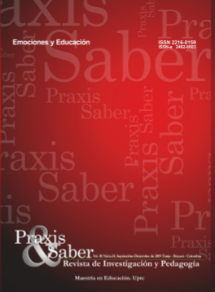The influence of coordination on the attention stability of children with different nervous system typologie

Abstract
The aim of the study is to define the influence of coordination abilities on attention stability development in first graders with different strengths of nervous system. Sixty 7- to 8-year-old schoolchildren from a usual comprehensive school participated in the research. Prior to the research, all children had been differentiated on equal 3 groups. The pedagogical experiment continued 7 months. During research there were changes in the groups. In the group KG, in the Shuttle run test, indicators have worsened from 10,3±0,6 s. to 10,4±0,6 s. (P>0,05), and in the methodic Bourdon Test indicators have worsened on 0,1 p. (P>0,05). In the group EG-2, in which schoolchildren were engaged taking into account the nervous system typology, there were considerable and positive changes. In the Shuttle run test indicators have improved from 10,3±0,6 s. to 9,7±0,5 s. (P<0,05), and in the methodic Bourdon Test indicators have improved on 1,4 p. (P<0,05). If the differentiated approach based on the typology is used, the indicators of movement coordination and attention stability will improve considerably during training.
Keywords
coordination abilities, differentiated approach, attention stability, types of nervous system, younger schoolchildren
References
Alexandrova, V., & Shian, V. (2014). Some types of the coordination abilities of the athlete-dancers. Uchenye zapiski universiteta imeni P.F. Lesgafta, 112(6), 12-17. https://doi.org/10.5930/issn.19944683.2014.06.112.p12-17
Bakulev, S., Dveyrina, O., & Savvina, A. (2006). Differentiated approach to the determination of major sports coordination abilities boxer. Uchenye zapiski universiteta imeni P.F. Lesgafta, 20, 3-9. https:// doi.org/10.5930/issn.1994-4683.2006.20.p3-9
Book, J., & Shirn C. (1997). Almanac of psychological tests. Moscow: KSP
David, F., & Cramer H. (1947). Mathematical methods of statistics. Biometrika, 3-4(34), 374. https://doi.org/10.2307/2332454
Drozdovski, A. (2015). The connection between typological complexes of properties of the nervous system, temperaments, and personality types in the professions and sports. Open access journal of sports medicine, 6, 72-161. https://doi.org/10.2147/OAJSM.S75612
Feoktistov, M. (2010). Periods of sensitivity of development of physical abilities among various contingents of pupils at average school age. Uchenye zapiski universiteta imeni P.F. Lesgafta, 62(4), 118-120. http://doi.org/10.5930/1994-4683.2010.04.62.p118-120
Furley, P., & Memmert, D. (2015). Creativity and working memory capacity in sports: working memory capacity is not a limiting factor in creative decision making amongst skilled performers. Movement Science and Sport Psychology, 6, 115. doi: 10.3389/fpsyg.2015.00115
Greig, M., Marchant, D., Lovell, R., Clough, P., & McNaughton, L. (2007). A continuous mental task decreases the physiological response to soccer-specific intermittent exercise. British Journal of Sports Medicine, 41(12), 908-913. https://doi.org/10.1136/bjsm.2006.030387
Holienka, M., Babic, M., Doležajová, L., Šelinger, P., & Musilová, E. (2017). Motor performance of young soccer players based on their biological age. Journal of Physical Education and Sport, 17(4), 2508-2512.
Holodov, Z., & Khuznetsov, V. (2009). Theory and methodics of physical training and sports. Moscow: Akademia.
Ion, C., Serghei, S., & Constantin, C. (2018). Differentiated physical training within the framework of a yearly training cycle of young footballers specialized on the position of goalkeeper. Journal of Physical Education and Sport, 18(1), 270-275.
Issurin, V., & Lyakh, V. (2017). Coordination abilities of athletes: basics of manifestation, evaluation and elucidation: a review. Journal of athletic enhancement, 6, 2. https://doi.org/10.4172/2324-9080.1000255
Kostyunina, L., Kiryanova, L., & Anisimova, Y. (2010). Special features of the manifestation of nervous system typological properties among sprint track and field athletes. Uchenye zapiski universiteta imeni P.F. Lesgafta, 62, 38-42.
Ljach, W., & Witkowski, Z. (2010). Development and training of coordination skills in 11- to 19-year-old soccer players. Human physiology, 1, 64-71. https://doi.org/10.1134/s0362119710010081
Lyakh, V., & Zdanevich, A. (2010). Work program on physical culture, grade 1-4. Moscow: Education.
Makarov, Y., & Hussain, A. (2011). Typological profile of person properties of the basketball players aged 16-18 years old depending on the style of game activity. Uchenye zapiski universiteta imeni P.F. Lesgafta, 73, 122-124.
Nemov, R. (2003). Psychology. Psychodiagnostics. Introduction to scientific psychological research with elements of mathematical statistics. Moscow: Vlados.
Oldham, J. (1993). Statistical tests (Part 2): parametric tests. Nursing standard, 44, 28-30. https://doi.org/10.7748/ns.7.44.28.s54
Pavlov, I.P. (1951). Complete works. Moscow: KSP
Polevoy, G. (2017). The spatial orientation of the players with different type of nervous system. International Journal of Applied Exercise Physiology, 6(4), 1-6. https://doi.org/10.22631/ijaep.v6i4.175
Polevoy, G. (2018). The Development of the Ability to Equilibrium Football players 10-11 years with different Nervous System. Journal of Medical and Health Sciences, 12(1), 496-499.
Raigorodskiy, D. (2017). Practical psychodiagnostics. Methodics and tests. Samara: Bakhrakh-M.
Sadowski, J., Wołosz, P., Zieliński, J., Niźnikowski, T., & Buszta M. (2015). Structure of coordination motor abilities in male basketball players at different levels of competition. Polish journal of sport and tourism, 21(4), 234-239. https://doi.org/10.1515/pjst-2015-0004
Santos, S., Coutinho, D., Gonçalves, B., Schöllhorn, W., Sampaio, J., & Leite, N. (2018). Differential Learning as a Key Training Approach to Improve Creative and Tactical Behavior in Soccer. Research Quarterly for Exercise and Sport, 89(1), 11-24. https://doi.org/10.1080/02701367.2017.1412063
Serova, L., & Voronov, A. (2013). Dependence of individual style of activity in table tennis on typological properties of the identity of athletes. Uchenye zapiski universiteta imeni P.F. Lesgafta, 95, 140-143. https://doi.org/10.5930/1994-4683.2013.01.95.p140-143
Shakhanova, A., Chelyshkova, T., Kuzmin, A., Silantyev, M., & Grechishkina, S. (2016). Effect of team sports on aerobic performance of human body in view of somatotype. Indian Journal of Science and Technology, 9(42). https://doi.org/10.17485/ijst/2016/v9i42/104257
Shawkat, R. (2014). The impact of development of the special coordination abilities on the general skill ability for table tennis juniors under 12 years old. International journal of science culture and sport, 4(2), 30-42. https://doi.org/10.14486/ijscs71
Sklyar, V. (2015). Usage of statistical methods in the pedagogical researches. Science Rise, 5(17), 39-43. https://doi.org/10.15587/23138416.2015.57049
Vespalec, T., Zhu, W., & Zvonar, M. (2014). Relationship between physical activity and coordination: a middle-age adult study. Medicine & science in sports & exercise, 46(5S), 770. https://doi.org/10.1249/01. mss.0000495808.88582.1f
